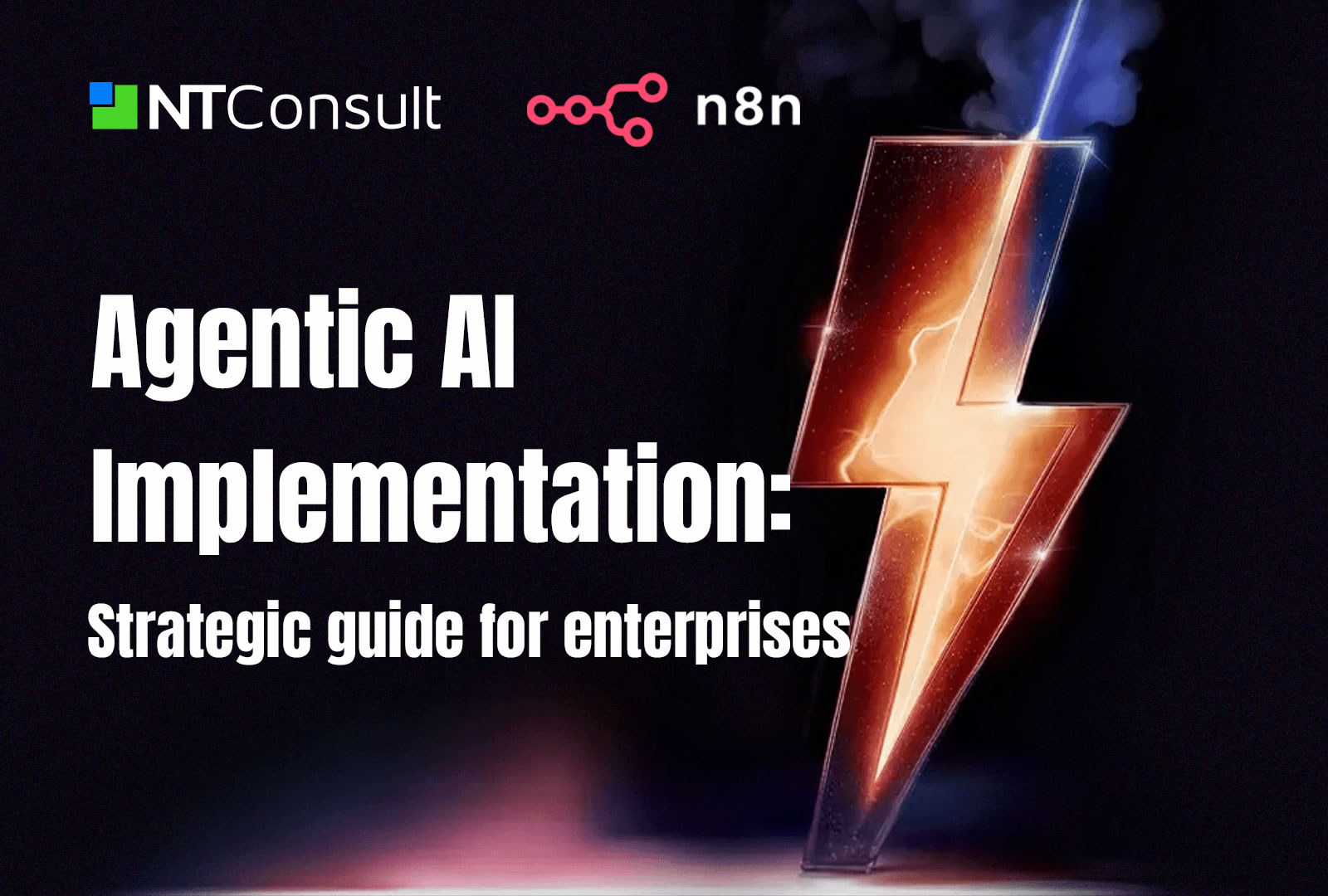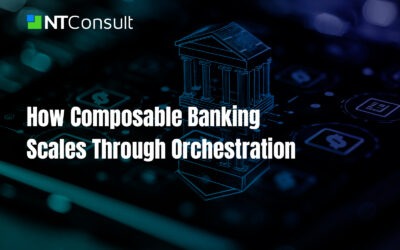Many organizations are experimenting with AI, but few are moving beyond isolated pilots and static chatbots. The real opportunity lies in agentic AI: systems designed to perceive, decide, and act autonomously beyond simply responding to prompts. Unlike traditional automation, these agents operate with purpose, navigating enterprise complexity to deliver measurable outcomes.
This article is a strategic guide for senior technical leaders ready to implement agentic AI in real-world environments. It introduces n8n as the central engine for building autonomous agents that connect data, models, and APIs in synchronized workflows.
At NTConsult, we go beyond proof of concept. Our team helps enterprises across regulated and high-complexity sectors, such as finance, telecom, and insurance, implement scalable agentic architectures combining orchestration, decision intelligence, and operational control.

Agentic AI isn’t about a future potential, but about building AI agents that actually work in your systems today.
What is Agentic AI and why it matters in enterprises
Agentic AI refers to autonomous systems that go beyond generating outputs: they plan, learn, and act across multiple steps to achieve defined goals. These systems combine perception, reasoning, memory, and execution via coordinated AI agents. Rather than waiting for prompts, they monitor context, evaluate options, execute tasks, adjust based on feedback, and even engage other agents or humans when necessary.
Different from generative AI, which produces content or suggestions, agentic AI is about taking action. It transforms AI from a passive assistant into an operational actor; one that can make decisions, execute tasks, and adapt based on real-world outcomes.
AI today is often discussed in broad categories, but each delivers fundamentally different types of outcomes:
- Predictive AI analyzes historical data to forecast future trends (e.g., churn prediction, risk scoring).
- Generative AI creates content: text, images, code, or responses. It’s useful for ideation and interaction.
- Conversational AI powers chatbots and voice assistants, often reactive and rule-based.
- Agentic AI, however, goes further: it perceives, reasons, remembers, and executes autonomously.
The expected outcome from predictive AI is insight. From generative AI, content. From conversational AI, interaction; from agentic AI, action goal-directed, adaptive, and measurable.
In enterprise environments, this means moving beyond workflows or dashboards. Agentic AI enables autonomous agents that monitor events, make context-aware decisions, and activate internal systems, whether that’s escalating incidents in telecom operations or triggering compliance workflows in finance.
Three capabilities define agentic AI:
- Perception: the ability to ingest real-time data from systems and APIs.
- Decision-making: processing that input using rules, logic, or AI models.
- Action: executing tasks directly in production environments, not just suggesting them.
This architecture requires more than just a model. It needs orchestration and execution capabilities, and that’s where n8n becomes critical.
As an open-source, extensible automation platform, n8n enables the construction of agentic AI by connecting LLMs, APIs, internal data sources, and real-time events into cohesive agents. These agents are not scripts. They are autonomous actors designed to work across complex, multi-system environments.
Harvard Business Review recently emphasized the rise of such agentic systems as the next evolution of enterprise AI, where the real value lies not in insight, but in intelligent action.
Agentic AI introduces a new operational layer where systems act with purpose, not just automation. It enables agents to interpret context, make decisions, and execute actions with autonomy, even in complex and dynamic enterprise environments.
Agentic AI vs traditional automation: what’s the real difference?
Traditional automation executes predefined tasks based on static rules or event triggers. It’s effective for routine operations but lacks flexibility or decision-making. Think of Robotic Process Automation (RPA) bots that input data into systems or scripts that send notifications. Fast, but blind to context.
Agentic AI replaces rigid task flows with agents that pursue goals. These agents plan, act, and adapt across systems based on real-time conditions and business logic.
In financial services, for example, an agent can analyze a flagged transaction, check it against compliance thresholds, and decide whether to escalate, approve, or request additional data.
In telecom, an agent might detect a network anomaly, isolate the impacted node, execute corrective procedures, and update the incident record without human coordination.
This is where n8n becomes essential. Unlike traditional Business Process Management (BPM) tools or RPA flows, n8n enables the orchestration of intelligent agents that think and act. It connects APIs, data, and AI models into decision loops that run continuously and autonomously.
Agentic AI doesn’t automate individual tasks. It delivers operational outcomes that are context-aware, fully traceable, and aligned with enterprise systems.
In practice, this means:
- A financial agent that reviews documents, applies business rules, and routes exceptions through a governed decision process.
- A telecom agent that analyzes performance logs and dispatches remediation actions directly across network systems.
The difference is execution power. Traditional automation follows. Agentic AI leads, with tools like n8n orchestrating the entire path from data to decision to action.
Beyond Chatbots: why enterprises need intelligent autonomous agents
When many leaders first hear “agentic AI,” they picture a smarter chatbot. But intelligent agents are not chatbots: they are autonomous systems capable of real-world action.
Chatbots are reactive. They respond to prompts, often within narrow domains. Agentic AI, by contrast, creates goal-driven systems that perceive, plan, and execute, operating across multiple tools, data sources, and organizational layers.
Consider the difference:
- A chatbot answers “what’s the refund policy?”;
- An agent initiates the refund, updates the system of record, triggers a confirmation email, and logs the transaction, all based on predefined objectives and live business context.
With n8n, these agents come to life. As a platform known for its open-source roots and enterprise adaptability, it empowers teams to:
- Connect models and logic (like GPT-4, LangChain, or domain-specific LLMs).
- Ingest and process business data from CRMs, ticketing systems, and APIs.
- Trigger conditional actions based on thresholds, exceptions, or events.
This makes n8n the operational layer for agentic behavior, activating real enterprise responses.
Enterprises in telecom, finance, and insurance are already building agents that:
- Escalate service failures across regions based on real-time thresholds.
- Coordinate approval workflows that combine AI judgment with human oversight.
- Trigger internal audits or updates when anomalies are detected in data streams.
Autonomous agents are a step beyond chats. They turn enterprise logic into enterprise action.
Explore how orchestration and integration elevate agentic design from idea to deployment.
Choosing the right approach: Low-Code, No-Code, or Full-Code?
Choosing the right development layer is key to building scalable, autonomous agents. Below we compare low-code, no-code, and full-code approaches in enterprise contexts:
| Approach | Target Profile | Flexibility | Speed to Deploy | Governance & Scalability | Example Platforms (NT-Ready) | When to Use |
| No-Code | Business teams / non-dev users | Low | Very High | Limited | Make.com, Zapier | Simple automations, internal workflows, MVPs without backend dependencies |
| Low-Code | Technical teams with integration needs | Medium–High | High | Strong with right design | n8n, ServiceNow, OutSystems | Agentic workflows, enterprise integrations, fast iterations with custom logic |
| Full-Code | Software engineers / DevOps | Very High | Low–Medium | Enterprise-grade | Node.js, Python (LangChain, FastAPI) | Custom agents, deep AI/ML pipelines, fine-grained control, mission-critical apps |
How to implement Agentic AI: a layered approach
Implementing agentic AI is not about installing a model. It requires an intentional, layered architecture that integrates data, decisions, and execution. For enterprises, this structure ensures modularity, scalability, and control, critical for operating in regulated, multi-system environments.
We recommend a three-layer approach to building real-world AI agents:
1. Model layer, where intelligence resides
This is where reasoning happens. It includes large language models (LLMs) like GPT-4 or Claude, as well as custom-trained models for NLP, classification, or forecasting. These models power the agent’s ability to interpret intent, analyze inputs, and generate meaningful responses.
2. Data layer, the context backbone
Agents are only as good as the data they see. The data layer connects structured sources (databases, APIs, logs) and unstructured documents (PDFs, emails). It supports both retrieval-augmented generation (RAG) and real-time event processing, essential for accurate, timely action.
3. Orchestration layer, where agents come alive
This is where n8n leads. The orchestration layer coordinates the entire lifecycle of an agent: receiving triggers, invoking models, interpreting outcomes, and executing decisions. It links systems together, enabling agents to act across boundaries, from legacy apps to cloud-native stacks.
With n8n, enterprises can:
- Design agents that monitor, decide, and act across workflows.
- Build in logic for fallback, retries, and human-in-the-loop escalations.
- Maintain visibility, auditability, and compliance at every step.
From LLM reasoning to real-time system actions, we help teams operationalize agentic design with a full-stack approach that connects models, APIs, and orchestration layers. This layered approach transforms automation into intelligent execution, unlocking new levels of speed, autonomy, and business alignment.
Orchestration layer: where NTConsult excels
The orchestration layer is where autonomous agents shift from concept to capability. It’s not just where decisions happen, it’s where those decisions become action. And this is exactly where NTConsult delivers exceptional value.
At the core of this layer is n8n, a platform that balances low-code flexibility with enterprise-grade extensibility. NTConsult uses n8n to construct agents that operate across enterprise systems, ingesting data, invoking AI models, and executing commands with autonomy.
Here’s how we use n8n to build real agents:
- Trigger-based logic: Agents are activated by business events, like incoming tickets, system anomalies, or user requests.
- Decision workflows: LLMs are embedded into n8n flows, enabling reasoning, classification, or response generation.
- Action chains: Agents can push updates to internal systems, activate external APIs, or notify human approvers when thresholds are breached.
This is far beyond “task automation.” It’s real-time decision orchestration with embedded governance, auditability, and exception handling.
While tools like Camunda are ideal for modeling structured business processes, n8n is where agentic AI becomes executable, allowing NTConsult to bridge the gap between strategy and action.
And we don’t just configure the flows. We co-create with your teams:
- Designing logic based on business KPIs.
- Embedding compliance requirements.
- Ensuring resilience with retries, alerts, and fallback paths.
This is how we align autonomous agents with real-world enterprise systems, delivering decision, action, and traceability in sync with business needs.
Tools that enable Agentic AI in the enterprise
and evolve intelligent agents across complex enterprise environments. At the center of many successful implementations is n8n: a powerful orchestrator that enables agents to perceive context, invoke models, and take action through system integrations.
While n8n plays a key role, NTConsult helps enterprises define architectures that match their operational reality, whether through visual orchestration, hybrid stacks, or full-code frameworks governed by business and compliance needs.
Enterprise tools for building Agentic AI
Once the architecture is defined, choosing the right stack becomes a matter of aligning capabilities to context. Below are the most relevant tools we deploy or integrate based on each use case:
1. n8n (open, extensible orchestration platform)
- Combines API integration, event handling, and LLM invocation.
- Ideal for visual design of agents with logic, memory, and execution.
- Extensible with custom code, making it suitable for both POCs and production.
2. LangChain + LLMs (e.g., GPT-4, Claude)
- Enables chain-of-thought agents with reasoning and memory.
- Frequently used in backend-driven agent architectures.
- Strong integration with vector databases, RAG, and prompt engineering.
3. AutoGen (Microsoft / OSS)
- Supports collaboration between multiple AI agents for task decomposition and role-based execution.
- Useful in complex coordination scenarios with inter-agent planning.
4. CrewAI / Autogen Studio
- Focused on teams of agents (e.g., planner, executor, validator).
- Adds layers of governance, reducing hallucination and enforcing structured reasoning.
5. Open Source Frameworks (Python, Node.js)
- Full-stack agent development with complete control over perception–reasoning–action cycles.
- Used for highly customized agentic stacks with fine-tuned performance and traceability.
6. UiPath AI Center
- Blends Robotic Process Automation with AI models to embed autonomy in structured automation.
- Effective in enterprises already invested in traditional automation tools.
7. NVIDIA Agentic Frameworks (NIM, GPUs)
- Designed for large-scale, real-time agents with embedded AI and hardware acceleration.
- Common in operational intelligence, edge computing, and telecom infrastructure.
8. Zapier + AI / Make.com
- Lightweight agent-like behavior for MVPs or internal use cases.
- Suitable for demonstration environments or non-critical automations.
Why n8n remains a strategic anchor
Among these, n8n stands out for enterprises looking to scale without compromising flexibility:
- Visual and extensible: accelerates prototyping and supports long-term maintainability.
- Modular and integrable: connects easily with LLMs, databases, CRMs, ticketing systems, and more.
- Governance-ready: enables traceability, human-in-the-loop escalation, and version control.
Comparative Summary:
| Platform | Primary Focus | Technical Level | Example Use Case |
| n8n | Orchestration + Execution | Medium | Build agents with visual logic and API integrations |
| LangChain | Reasoning + LLMs | High | Support agents that query data and make decisions |
| AutoGen | Multi-agent coordination | High | Agent collaboration for complex task decomposition |
| CrewAI | Agent teams | Medium/High | Planning, execution, and validation by specialized agents |
| UiPath | RPA with AI | Medium | Automate document workflows with NLP capabilities |
| Open Source Frameworks | Full customization | High | Agents built in Python with specialized logic |
| NVIDIA Agentic Stack | Scale + performance | Very High | Autonomous agents deployed on edge infrastructure |
Agentic AI is a design philosophy. Tools like n8n make it deployable, and we ensure it performs. It serves as the orchestration layer where intelligent agents connect models, context, and execution. Combined with tools like LangChain or custom APIs, it forms the operational core of agentic AI in production environments.
Real-world architecture example
Agentic AI is an architecture. And the most effective implementations follow a layered, modular design, placing orchestration at the center.
Below is a simplified architecture used in NTConsult-led projects across telecom and finance, where scalability, governance, and integration with legacy systems are non-negotiable.
Key Components of the architecture
1. Triggers & Event Layer
- Monitors operational signals (e.g., system logs, API calls, user inputs).
- Examples: webhook events from a CRM, ticket system updates, IoT alerts.
2. Orchestration Layer (n8n)
- Central brain of the agent, coordinating logic, flow, and decision-making.
- Activates based on triggers, invokes LLMs, and routes actions.
- Manages retries, confidence thresholds, exception handling, and logging.
3. Model & Reasoning Layer
- LLMs (e.g., GPT-4, Claude) for interpretation, classification, and planning.
- Integrated via LangChain or API endpoints.
- Supports memory strategies and tool-augmented reasoning (e.g., document parsing, classification, summarization).
4. Data & Context Layer
- Vector databases (for RAG), SQL/NoSQL, internal APIs, policy repositories.
- Provides structured/unstructured knowledge for informed decision-making.
5. Action Layer
- Execution of business operations: create tickets, update records, send notifications, invoke external services.
- Ensures traceability and feedback logging.
6. Monitoring & Governance Layer
- Observability pipelines, dashboards, and audit trails.
- Human-in-the-loop review where needed (e.g., approvals, risk thresholds).
Use Case: Telecom Agent for incident management
In a recent NTConsult implementation for a major telecom client:
- Trigger: network degradation event hits a performance threshold.
- n8n Agent: analyzes logs, checks historical context, invokes LLM to classify urgency.
- Decision: if critical, auto-opens a ticket, notifies engineering, and sends root cause hypothesis.
- Action: agent executes pre-approved remediation script and logs the result.
- Governance: all actions are logged, SLA timelines tracked, and human override enabled.
This is a thinking agent, operating across systems, with embedded intelligence and accountability.
From strategy to engineering
Moving from concept to production with agentic AI requires more than experimentation. It calls for architectural clarity, enterprise alignment, and systems that are built to operate, not just simulate, and that’s where NTConsult stands apart.
We help enterprises go from “What could an agent do here?” to “This agent is running in production, securely, reliably, and at scale.”
Our role across the lifecycle
1. Strategic framing
- We align use cases to business goals, identifying processes where autonomy can generate ROI, reduce latency, or increase compliance.
- We define agent profiles, triggers, inputs, and expected behaviors, turning abstract automation goals into structured execution plans.
2. Architecture & tool selection
- n8n is often our default orchestration layer, but we also design around LangChain, CrewAI, or custom stacks when needed.
- We assess your existing systems, data quality, security policies, and integration capacity, ensuring agent deployment fits your ecosystem.
3. Agent design & engineering
- Our multidisciplinary teams, engineers, AI specialists, solution architects, work in agile squads to build full agents.
- We embed LLMs where needed, model decision logic, implement fallback mechanisms, and ensure explainability.
4. Governance, security, and integration
- Agents built with NTConsult include monitoring, logging, version control, and auditability.
- We integrate with core enterprise systems: Salesforce, Camunda, ServiceNow, Kafka, Azure, and more, ensuring continuity and compliance.
5. Scaling & support
- Once validated, agents are scaled across units or geographies with NTConsult’s nearshore support model.
- We enable continuous evolution through performance dashboards, A/B testing, and usage feedback loops.
Why enterprises choose NTConsult
- We don’t deliver tools, we deliver outcomes: intelligent agents that solve real problems, at real scale.
- We combine engineering with ownership: no black-box models or throwaway POCs, everything is observable, testable, and maintainable.
- We integrate, not isolate: every agent is connected to your people, your processes, and your operational metrics.
From blueprint to production, we turn agentic AI into operational reality, reliably, securely, and with measurable results.
Why agentic AI is a step behind, and a leap forward
Agentic AI is not another layer over automation, it’s the foundation under it. Before choosing a platform, a tool, or even a methodology, enterprises must make a more fundamental decision: do you want systems that wait to be told what to do, or agents that know what needs to be done?
That’s the promise of agentic AI. Not just automation, but autonomous capability.
We’ve seen this shift firsthand. Enterprises aren’t just asking for Robotic Process Automation extensions or chatbot upgrades. They’re rethinking their operating model around agents that learn, adapt, and act, across functions, platforms, and architectures.
This shift reorders the priorities:
- Salesforce, ServiceNow, Camunda, or n8n may become part of the delivery stack.
- But the first decision is architectural: how do we design, build, and orchestrate intelligent agents that drive outcomes?
That’s where NTConsult comes in, not as a vendor, but as a co-creator. We help enterprises build the thinking layer before the execution tools. We embed strategy in every agent, so that intelligence isn’t a feature, it’s the default.
We call them Business Agents, autonomous systems that:
- Understand business context
- Execute decisions end-to-end
- Integrate with humans and systems
- Deliver explainability, compliance, and real ROI
From the first blueprint to scalable deployment, our multidisciplinary teams design agentic systems that align with your governance, tech stack, and ambitions.
Whether you start with n8n, LangChain, Camunda, or a fully agnostic architecture, we ensure that agents become part of your business DNA, not just another project.
Contact us to learn how we build, orchestrate, and scale intelligent AI agents using n8n, from strategy to implementation.
Frequently Asked Questions (FAQ)
1. How is agentic AI different from traditional automation or RPA?
Traditional automation follows predefined rules or scripts. Agentic AI introduces autonomy, agents perceive context, reason through options, and act independently across systems. The goal shifts from task automation to outcome orchestration.
2. Is agentic AI just an advanced chatbot?
No. Chatbots are typically reactive and dialog-based. Agentic AI systems can plan, take action, invoke APIs, escalate decisions, and coordinate across tools. Some may have a conversational interface, but their core is operational logic and autonomy.
3. What’s the business value of agentic AI?
It reduces operational overhead, accelerates decision cycles, and improves responsiveness in complex environments. In finance, it can handle exception workflows. In telecom, it can detect and correct network anomalies without delay. Value comes from agents that act, not just respond.
4. Is this secure and compliant with enterprise governance?
Yes, when architected correctly. Agentic AI agents can be designed with auditability, fallback logic, approval checkpoints, and data isolation. Platforms like n8n support human-in-the-loop escalation and version control, enabling compliance alignment.
5. Do I need LLMs to implement agentic AI?
Not necessarily. While LLMs enhance reasoning and language understanding, many agentic workflows can be built around structured data, APIs, and business rules. LLMs become powerful when used for decision support, classification, or summarization.
6. How does this fit with my current stack (CRM, ERP, etc.)?
Agentic agents don’t replace systems, they integrate with them. Tools like n8n connect agents to Salesforce, SAP, ServiceNow, custom APIs, and databases, enabling orchestration across your existing landscape without disruption.
7. What kind of ROI should we expect?
ROI varies by use case, but typically includes reduced manual work, faster exception handling, fewer escalations, and better SLA compliance. NTConsult focuses on production-grade delivery with measurable outcomes, not theoretical efficiency.


 Portuguese
Portuguese Spanish
Spanish


